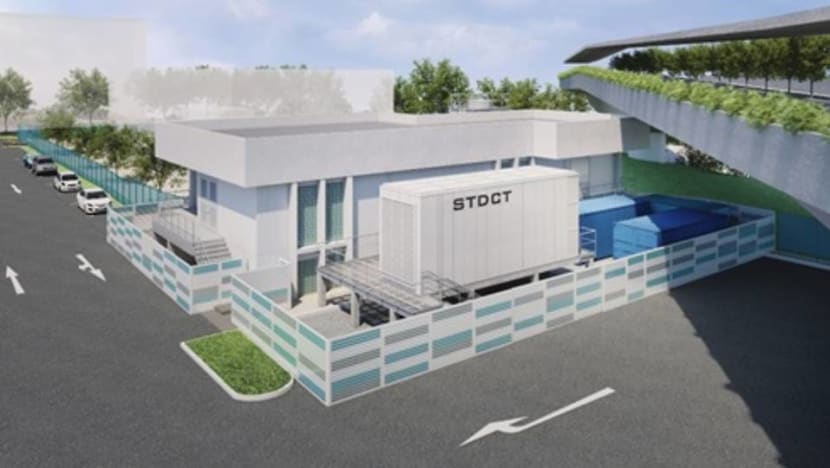NUS, NTU set up S$23 million programme to test cooling solutions for data centres in the tropics

An artist’s impression of the new Sustainable Tropical Data Centre Testbed (STDCT) which will be set up at the National University of Singapore. (Illustration: Facebook)
SINGAPORE: Temperatures ranging from 23 to 27 degrees Celsius and ambient humidity of 50 to 60 per cent are typically the conditions needed to air-cool a data centre housing powerful computers and rows of servers.
But to maintain a controlled environment like that requires plenty of energy, even more so if the data centre is set in a tropical location like Singapore.
To develop novel and more energy-efficient ways of cooling data centres in the tropics, a new S$23 million research programme was announced by the National University of Singapore (NUS) and the Nanyang Technological University (NTU) on Wednesday (Jun 16).
As part of that, a testbed facility with “state-of-the-art” equipment will be set up at the NUS Kent Ridge campus and will be up and running by October.
The Sustainable Tropical Data Centre Testbed (STDCT), as it is called, will “promote the co-creation and demonstration of advanced cooling technologies”, the universities said in a joint press release.
READ: Singapore puts ‘temporary pause’ on new data centres: Why and what it means for the industry
The programme is jointly funded by the National Research Foundation Singapore (NRF), a department under the Prime Minister’s Office, and Facebook, which is the anchor industry partner.
Research at the STDCT will be co-led by researchers from the NUS, NTU and industry partners such as Keppel Data Centres, with support from the relevant government agencies.
“Companies will share their needs and requirements with the research community to ideate and innovate the solutions,” the press release said.
One area that researchers are examining is a heat sink design with both air and liquid modes of cooling in a single integrated piece that eliminates the connectors and ducts.
Led by NUS associate professor Lee Poh Seng, who is also the programme director at STDCT, this “direct chip hybrid cooling” idea can be an alternative air-cooling solution during water-loop maintenance to cut down server downtime.
Another, led by NTU’s Associate Professor Tan Rui, will test the possibility of air-cooling data centres at higher temperatures and relative humidity levels to reduce energy consumption yet ensuring the performance of the IT equipment.
READ: Singapore must ensure digital infrastructure is environmentally sustainable, says Desmond Lee
When successfully developed and tested, a combination of the new cooling technologies being studied at the STDCT could reduce energy consumption and greenhouse gas emissions by “up to 25 per cent”, compared with data centres that are traditionally air-cooled.
An industry-wide adoption across the entire tropical region can also potentially cut the industry’s energy usage by “at least 40 per cent”, the press release said.
“The demonstration and validation of innovative cooling technologies at the testbed facility can greatly mitigate the operational and financial risks of adopting these solutions,” the universities said.
“This will accelerate adoption, as well as enhance the sustainability of the data centre industry in Singapore and the wider tropical region.”
In the longer term, the STDCT hopes to recommend operating guidelines and set new standards based on proven findings from its new technologies to enable greener data centres.
Meanwhile, the facility itself will feature energy-efficient cooling solutions, such as the StatePoint Liquid Cooling System developed by Nortek Air Solutions and Facebook that helps data centres to operate more efficiently in tropical locations.
GREENING DATA CENTRES
The rise of the digital economy has led to growing demand for data centres but the booming industry’s huge energy needs are also raising concerns.
The International Energy Agency estimates that the sector currently uses around 1 per cent of the world’s electricity. This figure could hit double-digits by 2030, making related emissions a problem.
In Singapore, data centres accounted for 7 per cent of the country’s total electricity consumption last year. This is projected to reach 12 per cent by 2030, the universities’ press release said.
With the industry being an “intensive” user of electricity and water, a “temporary pause” has since been imposed on the building of new data centres as local authorities mull a balance between environmental sustainability and supporting business needs.
The Government has said it is in the midst of concluding its review and intends to share its plans with the industry later this year.
READ: Commentary: When our insatiable appetite for data can harm the environment too
NRF’s chief executive Low Teck Seng said the STDCT will help to accelerate the development and test-bedding of innovative and sustainable solutions for data centres towards commercial deployment.
It will also support Singapore’s journey towards becoming a low-emissions economy as part of the foundation’s Energy Grid 2.0 programme, he added.
The Infocomm Media Development Authority (IMDA), which is supporting the research programme, said it will work closely with the industry to bring about more energy-efficient data centres and encourage the adoption of best-in-class technologies, solutions and standards.
“This will enable us to grow our data centre ecosystem sustainably and further entrench Singapore as one of the world’s leading data centre hubs,” said cluster director for infrastructure planning and facilitation Yeo Tiong Yeow.












